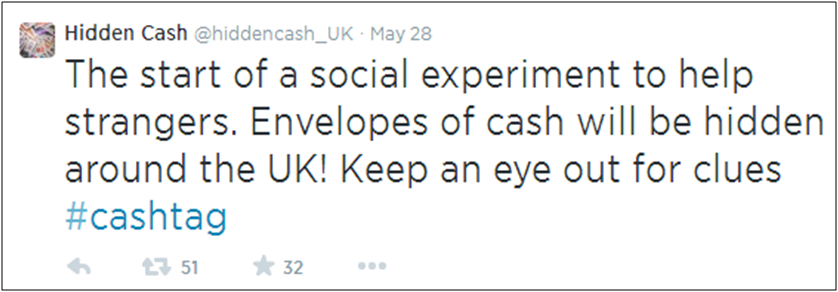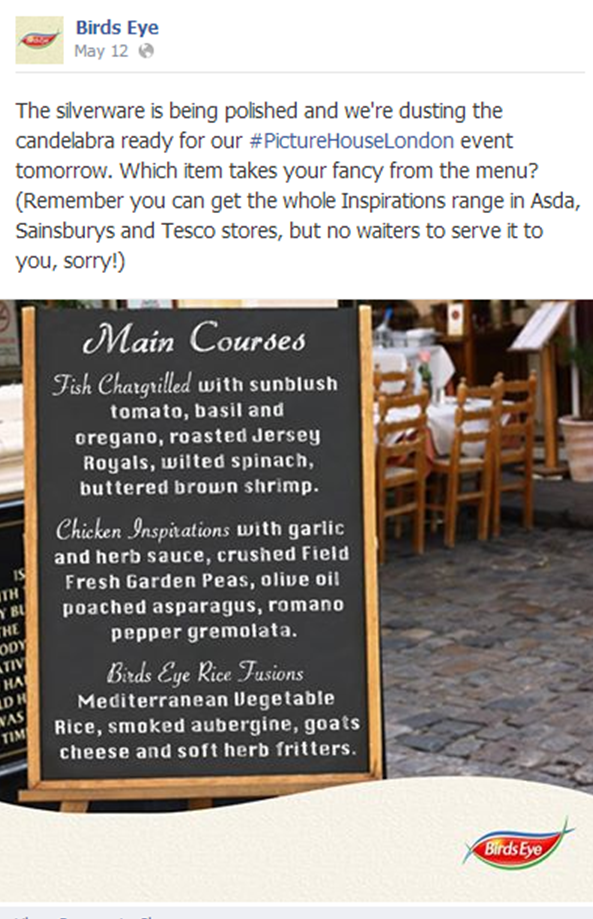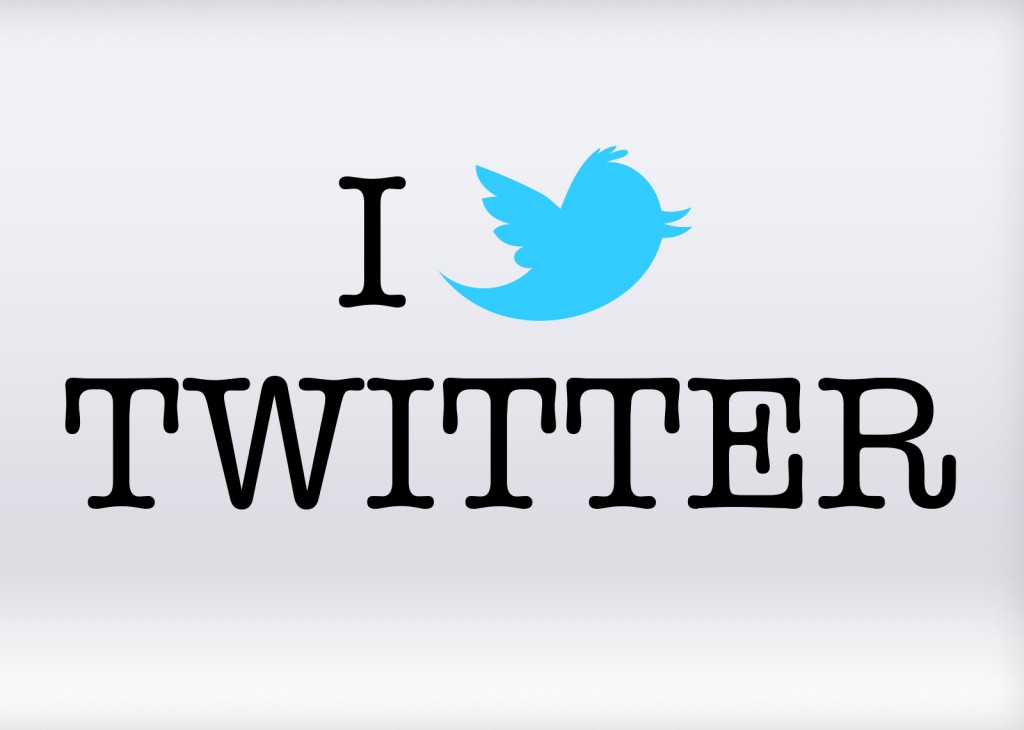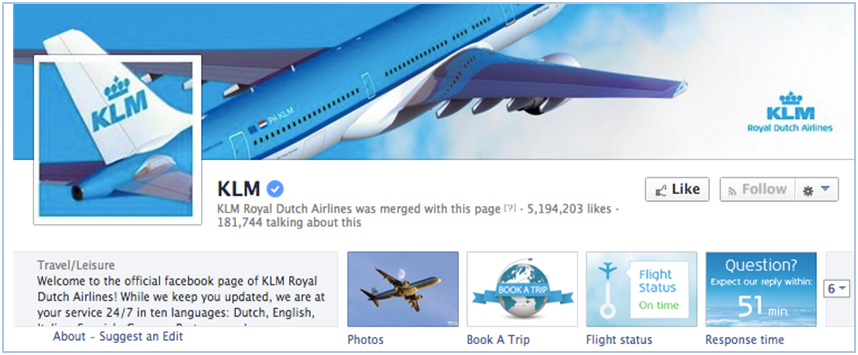The treasure hunt started last month using the following handle @HiddenCash_uk.
Hidden Cash UK was inspired by the US version, which started in California on the 23rd of May. A secret millionaire had the genius idea to hide money in places in order to give something back to his community; his identity was recently revealed. (more…)
Social Media marketing campaigns can be surprising, both in a good and bad way.
I don’t know anyone who would say no to a free lunch; so already the brains behind this campaign from Birds Eye are onto a cracking idea! Birds Eye is offering a free meal to anyone who tweets or ‘Instagrams’ a picture of the meals they’re being served, at the first ‘pay-by-picture’ restaurant. Of course, there is a hashtag to add: #BirdsEyeInspirations.
This innovative marketing campaign is aiming to change the perception that people have about frozen food, and by going out and meeting their customers Birds Eye are hoping to be on the road to achieving this.
The pop-up restaurant called The Picture House opened its doors at the Ice Tank in Soho this week for 2 days (sorry – it won’t be forever!), and will also be going to Manchester and Leeds next month. Unfortunately you all missed it this week – but there’s still a chance the pop-up returns to London, if the event is successful!
So, would YOU try the Birds Eye pop-up restaurant?
Happy Birthday Twitter!
It was 2011 when Tania, a social media entrepreneur from Brazil, introduced me to this great tool. Not everybody knew about it, but thanks to TV, magazines, coffee shops and celebrities, this social medium has become popular.
To mark this anniversary, here’s a list of 50 Reasons why I love Twitter and why, in a world where e-mails are too long and calls are annoying, you may want to consider using it at work and for fun:
- Simplicity
- It’s made of 5 tabs only: home, notifications, hashtags, me and private messages
- It’s real time communication
- It’s only 140 characters so I’ll get to the point when I message you
- It’s public so I can contact (aka mention) you even if I don’t know you, stranger
- If you are interested in my tweet you can reply
- It’s pure networking in our fast pace world
- You can reach out journalists, bloggers, marketing managers and even celebrities
- It’s up to your tweet style and your message to attract attention. You control the medium
- It’s something that reminds me of old computer programs like Amiga and Atari (I am nostalgic)
- You can use other people/brand influencer power to boost your followers and gain influence
- It’s a rat race on who has more followers
- It’s a place to spread your ideas
- It’s a place where bad ideas have a short life and good ideas get retweeed
- It’s a place where you can create activist movements or satirise politicians. Even the pope is there! (but what he’s doing there, nobody knows)
- It’s a tool where you can help others and others may help too
- If you look at an area hashtag you can have a real time feeling of what’s going on (or perhaps some people are just talking rubbish about it)
- You can discover places you wouldn’t see advertised on TimeOut thanks to hashtags
- It’s a place where you can credit of what you have done (Tweet This : 50 Reasons Why Twitter Has Made Your Life Better by @carlopandian ) (more…)
As well as sending and receiving ‘messages’, users can also ‘heart’ posts, reply to the post with an anonymous post/picture of their own, or send a direct message to a user.
Now, can an anonymous social network gain a place at the crowded social media table? Anonymity is definitely a competitive advantage. Finally, we have a social media channel where everybody can actually express themselves freely, without the threat of backlash or worse having friends and family commenting and leering at your post! Whisper presents an opportunity for users to address more delicate and difficult subjects, and even rumours & whispers.
Although Whisper hasn’t released any official user numbers, there has been over a million downloads on the Google Play store. Yet Whisper unquestionably offers a great platform for content marketing and advertising, for both brands and marketers.
Hulu, the online US video subscription service, are the first to use the app as an advertising platform, with a campaign for one of its shows, ‘Deadbeat’ starting this week. Though it remains to be seen, whether Whisper will become a popular channel for story telling and increasing brand visibility.
So, will you use the “anti-Facebook’?
If you haven’t already, look at a branded YouTube channel and see what’s to see what you can use in social media conversations or link building activities. Let’s focus on how you can use video content in your content marketing outreach activities…
How can you identify kick ass content?
It’s thought that you are an artist if collectors buy your work. Similarly, kick ass content is valuable if it appeals to specific online communities. It’s a good sign if publishers such as bloggers and online magazines want to share these YouTube videos. This is content that works!
By matching YouTube videos to possible target audiences, you can see if the content can sit in other sites thus amplifying the message to more communities. You could also search for the video title in Google and find out if some publishers have already embedded the content. If the content has already been picked up naturally by a certain niche, you can build up a longer outreach list in that space to increase the visibility of the content.
Alternatively you could search for similar videos produced by a competitor to find out if it’s been picked up.
Often YouTube channels presents a mix of promotional, funny and informative content and the last two types are often more effective in the outreach.
When you discover a video that could be of interest for a set of online communities, it’s time to test.
Pro tips:
– Take into account how the publishers interests could clash with the messages expressed in the video.
– Avoid focusing on over promotional content. A great video with a sale slogan at the end could prevent many leads.
Royal Dutch Airlines (KLM) recently illustrated how customers’ payments can now be processed through their social media channels. Passengers are now able to book a ticket, an upgrade or add extra baggage via KLM’s Facebook and Twitter accounts.
In fact the implementation of this payment service seems quite easy: the passenger simply sends a request via private message, and subsequently receives a private message that contains a link to a payment method and the transaction goes through. The system is particularly effective via Facebook. In fact, there is no need to go onto KLM’s website anymore; flights can be found directly via the ‘Book a Trip’ tab, where flights can be bought directly from that page.
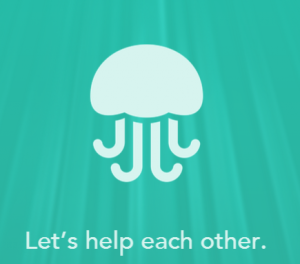
Have you used Jelly yet? It’s a mobile app that lets you ask questions to your friends and extended circle of friends. Simple take a picture or frame a question about a topic you wouldn’t ordinarily ask a search engine and watch the socially-sourced responses pour in. Currently there are only a few brands using the service, in part to ask questions from their consumers or readers but the results look promising. There is a great deal of potential for generating ideas using your social networks and allowing co-creation to take place on the platform. Like a smart, mobile version of Quora. The functionality is improving and the number of active users are growing worldwide. You heard it here first!
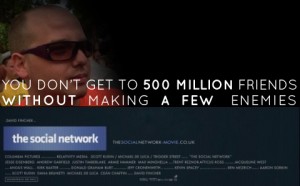 Was it Twitter’s share price taking a tumble? Or Facebook announcing that Q4 2013 was their biggest ever quarter for advertising spend? Or is the news that it was 10 years to the date that a lowly Harvard student launched a social network in his dorm room that is now worth approximately $157 billion and boasts over 1.23 billion members worldwide? Well sort of, because to celebrate their 10th birthday this month, Mark sent us all a little thank you note inviting us to view and publish our very own one minute long Facebook Movie – a cheeky little roundup of our life in pictures since the year that we joined the network (the year when we all became ‘Friends’… aww). So how has this lovely idea of Mark’s gone down?
Was it Twitter’s share price taking a tumble? Or Facebook announcing that Q4 2013 was their biggest ever quarter for advertising spend? Or is the news that it was 10 years to the date that a lowly Harvard student launched a social network in his dorm room that is now worth approximately $157 billion and boasts over 1.23 billion members worldwide? Well sort of, because to celebrate their 10th birthday this month, Mark sent us all a little thank you note inviting us to view and publish our very own one minute long Facebook Movie – a cheeky little roundup of our life in pictures since the year that we joined the network (the year when we all became ‘Friends’… aww). So how has this lovely idea of Mark’s gone down?

